Daikin air conditioner error codes: identification of malfunctions and methods of dealing with them
An air conditioner is a complex unit, consisting of a large number of elements.Even the most advanced equipment, which includes the Daikin air conditioner, is not immune from failure of any of them. In order to quickly identify the causes of problems, manufacturers equip their models with self-diagnosis systems.
Through a combination of letters with numbers and light signals, “smart equipment” informs about any violations in its own operation. The display system displays error codes for the Daikin air conditioner on the control panel display. If there is any malfunction, the corresponding signal begins to flash.
This article introduces the alphanumeric designations of breakdowns, their interpretation, causes of occurrence and methods of elimination.
The content of the article:
Air conditioner self-diagnosis system
All Daikin air conditioner models are equipped with a self-diagnosis system. With its help, they diagnose their condition themselves and then inform them about the problems found. You can run this function in a special mode, but it also works automatically.
Almost all failures can be identified by observing the indicators, and the mechanism of this process is very simple. Under normal conditions, LEDs emit an even light. But as soon as a violation occurs, they begin to pulsate, followed by repeated outbreaks. An alphanumeric or letter combination appears on the remote control display.

Having practiced deciphering encoded information about breakdowns, you can understand that a home craftsman is quite capable of eliminating some faults on his own. If the failures are complex, then by informing the technician of the code, the user will speed up the repair process.
Classification of fault codes
The letter at the beginning of the code indicates the structural part in which the malfunction occurred:
- failure in the indoor unit - “A”, “C”;
- failure in the power section - “E”;
- malfunction of temperature sensors - “F”;
- problems with nutrition - “N”;
- problems in the external unit - “L”;
- the fan motors are blocked, the drainage pumps or the electronic board of the indoor unit are faulty - “P”;
- system failures - “U”, “M”.
Errors that are not critical and occur rarely are encrypted with a combination of numbers.
Common problems with Daikin air conditioner
Most malfunctions of the Daikin air conditioner, especially its indoor unit, are not complicated. Errors shown on the display consist of a classification code (letter) and an error number (digit), a number and a letter, or two letters.
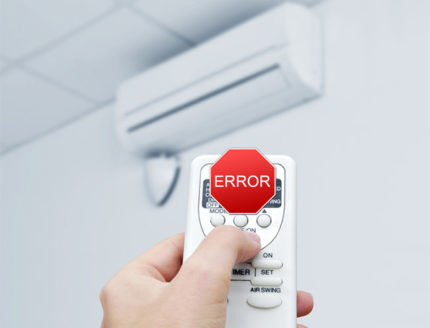
Not only for different brands, but also for different lines, the codes are slightly different. For this reason, you need to read the instructions. It presents transcripts of coded violations and methods for eliminating them.
Indoor unit errors
When the general safety device is triggered, the code starts flashing JSC. There are many reasons for this:
- overheat compressor;
- failure of fans;
- insufficient amount of refrigerant in the system;
- debris in the capillary tube, other.
Among all the reasons, the most difficult is the malfunction of the electronic part. To eliminate it, you need not only a professional tool, but also experience.
A faulty circuit board indicates a fault code A1. As practice shows, the control board is often diagnosed incorrectly. Therefore, before changing it, you need to check the components that most often fail - relays, capacitors.
Among the common reasons for the failure of the control board are only five:
- network voltage instability;
- improper installation of interconnect cables;
- natural wear and tear of individual board elements;
- moisture ingress, destructive mechanical effects;
- non-compliance with operating rules.
Often the air conditioner fails due to improper preparation for winter. When the device is de-energized, only the phase is turned off and the zero is forgotten. In this case, the electronic board, provided it is grounded to a common line, can be damaged by welding work carried out nearby.
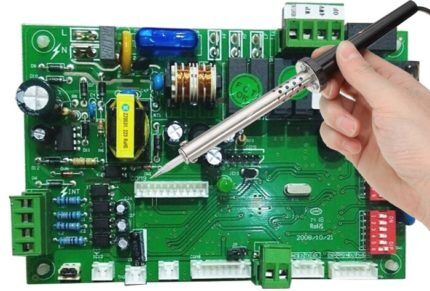
Code A2 indicates that the fan motor is blocked. When the self-diagnosis system displays a Daikin air conditioner fault code indicating a fan motor failure, you should try turning the blades manually. If there is no free rotation, the cause is worn motor bearings and will have to be replaced.
The fan motor activates the rotary switch.The contacts inside it corrode over time and stop passing electric current. To make sure that the rotary switch does not conduct electricity, you need to use a multimeter. If continuity of the switch is confirmed, it must be replaced.
An abnormal level in the drainage system is indicated by code A3. Excess moisture due to improperly arranged condensate drainage may cause damage due to short circuit. In this case, you will need to disassemble the indoor unit and thoroughly clean the drainage system.

A4 codes And A5 indicate a malfunction of the heat exchanger and abnormal temperature. This is caused by an error in the temperature sensor.
You can check if this is true as follows:
- The temperature sensor is disconnected from the board.
- Check the resistance on the sensor using special equipment.
- The measurement result is compared with the specified values. At a temperature of +25⁰ on a working sensor, the resistance should be 10 kOhm. If the condition is violated, the sensor is definitely faulty and must be replaced.
- If measurements show that the resistance of the sensor meets the standards, it is installed in its place, connected to the board, and the unit itself is connected to the network.
- Next, check the connector using a multimeter. If the voltage exceeds 4.9 V or is less than 0.5 V, the board must be replaced.
- If the voltage on the connector is normal, the microprocessor is faulty and must be replaced.
If the fan motor is overloaded, the self-diagnosis system displays error code A6. The cause may be a disconnected or broken wire, a contact defect, or damage to the printed circuit board.

Display errors A7 indicates a malfunction of the blind drive. The motor valve may be faulty; you need to check the connections to make sure that nothing is blocking the movement of the blinds.
Most often the cause is a motor malfunction. In this case, simply replace it. There is also the possibility of microswitch failure, PCB failure, or connector connection defects.
An error such as general overcurrent has code A8. Since the starting current of the compressor motor is significantly higher than the operating current, the system issues a signal three seconds after the motor starts.
Overloading can lead to a fire hazard, so you need to start identifying the reasons immediately. This situation can be caused by a short circuit in the compressor itself.
In this case, the system decides that there is a short circuit because the current increases to a significant value. A short circuit can also occur outside the compressor - in the control board, at the terminals, in the supply wires.
The cause of error A8 may be an excessive increase in pressure in the discharge system.An increase in this indicator can be caused by errors made during refrigerant charging.
Untimely cleaning of the heat exchanger gives the same result. Even a thin film of fat on the surface of a visually clean heat exchanger can interfere with proper heat exchange.
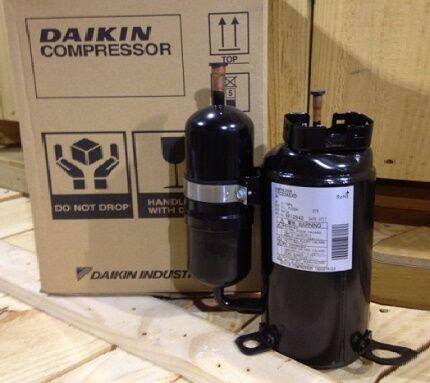
Code A9 indicates a faulty electronic expansion valve. Failure may occur due to mechanical contamination. To check its operation, the power is turned off and then turned on again. Immediately after power is applied, the expansion valve should start operating within 30 s.
During this period, it is determined whether there is a 12 V voltage pulse in the middle of the expansion valve diode contacts. The absence of a pulse indicates a breakdown of the control board.
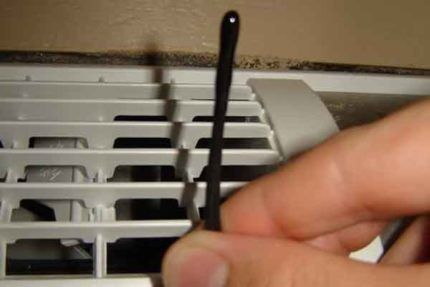
If, while the indoor unit fan is running, the condenser fan stops, the compressor or expansion valve turns off, take the following actions:
- on the control board, the contacts of the electronic valve are disconnected;
- check whether there is a rated voltage on the board.
If the nominal voltage is present, this indicates a malfunction of the electronic expansion valve.No voltage indicates a faulty control board.
Error codes of the indoor unit, indicated by the symbol “C”, are summarized in the table:
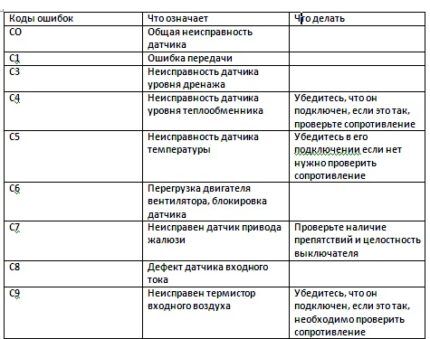
Deciphering the error code, consisting of the following symbols:
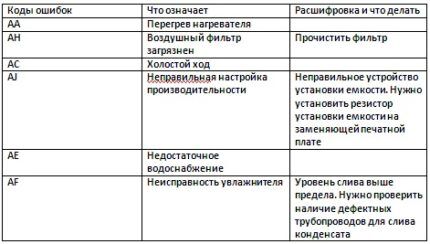
One of the most unpleasant malfunctions is the breakdown of the valves responsible for draining fluid. It entails a complete replacement of unusable parts.
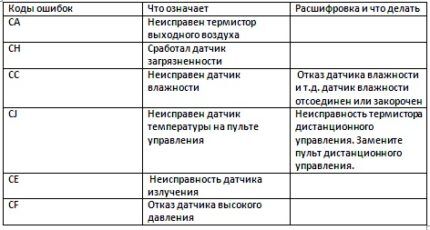
Before contacting a service center, you should turn off your household air conditioner for a while, then turn it on again. After restarting, the error may not appear. If the code flashes again, you cannot do without a wizard.
Outdoor unit errors
The instructions included with the air conditioner describe how to eliminate certain defects. They can be implemented in case of individual malfunctions of the indoor unit. Errors on the outside and system problems are more complex, so it is better to contact a specialist.
Wink EO code indicates that the general protective device has tripped. This means that the self-diagnosis device has detected some kind of anomaly.
Operation may be disrupted for several reasons:
- the input connection of the safety device is damaged;
- seat belts are disconnected or broken;
- the shut-off valve is installed in the closed position;
- the refrigerant piping circuit is clogged;
- the external control board is faulty;
- an air short circuit occurred.
Error under code E1 indicates that the printed circuit board of the split system control is faulty. When the power supply is turned on E2PROM not working correctly.
When the high pressure sensor (HPS) is triggered, the error E3. It occurs when the compressor is running when the high pressure switch is turned on.
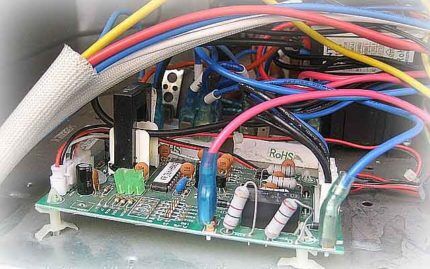
The failure may be caused by an excessively high pressure level caused by a large volume of refrigerant or non-condensable gas.
There are other possible reasons:
- defective high pressure switch;
- disconnection or damage to the high pressure wire bundle;
- loss of contact in the high pressure connector;
- damage to the printed circuit board;
- damage to the circuit through which the refrigerant circulates;
- clogged air filter of the indoor unit;
- clogging of the external heat exchanger;
- failure of the outdoor fan in cooling mode.
When the Low Pressure Sensor (LPS) is activated, the code E4. The compressor is running at this time, and the error appears when the low pressure switch is activated. The reasons may lie in a malfunction of the coolant circuit, or the low pressure switch may also be faulty.
The low pressure wire connection may become loose or broken. The possibility of a defect in the connector or printed circuit board cannot be ruled out. The shut-off valve may remain in the closed position.
If the compressor motor is overloaded, the system signals error E5. It indicates that the compressor is activated due to thermal protection or the discharge pipe is overheated.
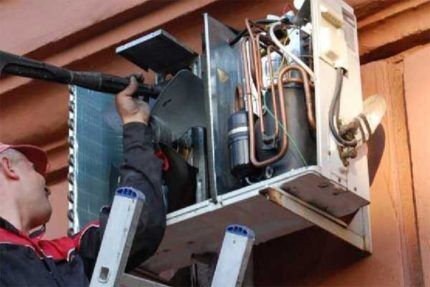
Failure may be caused by a faulty shut-off valve, insufficient refrigerant, damaged outdoor unit, faulty 4-way valve or faulty electronic expansion valve.
Error E6 notifies about blocking of the compressor motor by increasing current.
At this time, current protection is triggered due to:
- high blood pressure level is excessively high;
- there is a voltage drop;
- the shut-off valve does not open;
- the compressor is faulty.
Error E7 — the fan motor is blocked due to overcurrent. The failure may be due to a malfunction of the fan, a disconnection from the fan motor or the printed circuit board of the wire bundle or connector. It may simply be a matter of poor contact or foreign objects stuck in the fan.
With a general current overload, a error E8. In this case, the inverter input current is greater than 28 A for 2.5 s. Reasons include compressor failure, defect in the power transistor, printed circuit board of both the outdoor and indoor units, and short circuit.
Error E9 - signal about damage to the expansion electronic valve. It appears when the circuit is broken.
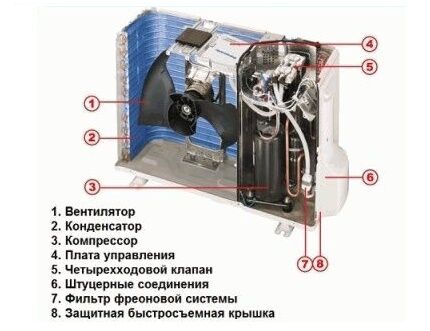
Error under code EA indicates the occurrence of a 4-way valve abnormality. Origin of the failure:
- poor contact in the connector;
- the thermistor is damaged;
- the outdoor unit is faulty;
- 4-wire valve coil is faulty;
- the 4-wire valve itself is faulty;
- There is a foreign substance mixed with the refrigerant.
EU code indicates an abnormal water temperature due to a malfunction of the outdoor unit or thermistor. If there is an error EJ additional protection is triggered. HER — there is an abnormal level of moisture in the drainage system. E.F. — The heat storage unit is damaged.
All errors related to power problems go under code "N". BUT - general sensor defect, indicates a failure of the compressor sensor system. This may occur due to faulty connections or the circuit board. H1 — failure of the air temperature sensor. This may be due to a faulty damper or limit switch.
H2 — the system power sensor is faulty. H3 - defect in the high pressure sensor. The error appears due to failure of the high pressure switch, disconnection of the wire bundle, faulty board, faulty connector.
H4 - defective low pressure sensor. You need to make sure that it is connected. If yes, then the switch needs to be checked for integrity. H5 — the compressor does not function, because The overload sensor has tripped. Here you need to look for a defect in the connector or in the compressor motor overload thermistor.
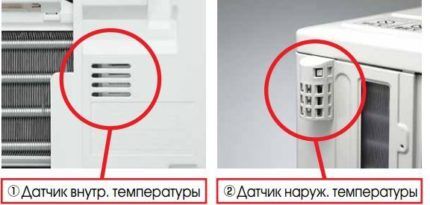
H6 — compressor overload.The compressor itself or the outdoor unit may be faulty. Abnormal input voltage or a closed shut-off valve may also cause failure.
H7 — the fan is overloaded. Probable causes: circuit failure, connector coming out. When the input voltage sensor is triggered, an error signal will appear under the code H8. Here the power transistor, gearbox or outdoor unit is presumably faulty. The internal wiring may be faulty.
H9 — not everything is in order with the outside air temperature sensor. Indicates that the thermostat resistance has exceeded the range of 60-600 kOhm. The external thermistor, thermistor connector, or printed circuit board may be faulty. Changes in thermistor resistance are inversely proportional to changes in temperature. The thermistor malfunction is determined using a multimeter.
If codes appear F0, F1, F2, which means the protections have worked. In the first case, No. 1 and 2, in the second - No. 1, in the third - No. 3. F3 appears when the discharge pipe temperature is high.
It can be caused by:
- inappropriate coolant volume;
- clogging pipeline;
- low drain temperature;
- exit from the thermistor holder;
- by disconnecting the expansion valve coil from its body.
Error F6 — exceeding the nominal value of the heat exchanger temperature. Such a failure is caused by clogged filters, heat exchangers, fan malfunctions, excess amounts of refrigerant, and the inability to open the shut-off valve.
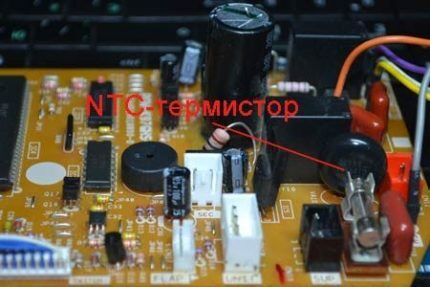
Code J0 indicates a thermistor malfunction. J1, 2, 3 — pressure, current, temperature sensors, respectively. J4 - this is a signal about a sensor defect in the low pressure saturation zone. J5, 6, 7, 8, 9 — malfunction of the suction pipe thermistor, heat exchanger 1 and 2, liquid pipe and gas pipe, respectively.
Errors with code "L" indicate problems in the inverter system. This can be either the activation of protective devices that shut down the inverter, or transmission errors between the external board and the inverter board. A defect in the printed circuit board or a malfunction in the power supply has the same effect. You need to try to reboot the system.
If there is insufficient coolant, an error will be displayed P0. Flashing code P1 indicates an imbalance in the power supply due to voltage mismatch between phases. This may also be a consequence of a defective main circuit capacitor, a malfunction of the magnetic relay, or incorrect wiring of the main circuit.
If the temperature inside the control unit rises, the code will indicate this P3. This is due to a defect in the thermistor or printed circuit board. You need to measure the resistance. P4, 5, 6 - errors indicating a breakdown of sensors - power transistor, direct current, output current sensor. P7 indicates a high output current.
Conclusions and useful video on the topic
The following video will clearly demonstrate the process of identifying and eliminating one of the common air conditioner errors:
The video will show you the steps to determine if the control board has failed:
The perfect self-diagnosis system of the Daikin unit allows you to quickly identify any malfunction. This helps eliminate operational errors before the equipment fails completely.
The user must not only decipher the codes, but also periodically clean the air conditioner. If faults are identified, repairs, depending on the complexity, can be performed on site or in a service setting.
In the block below you can leave a comment with your own impressions of the operation of the Daikin air conditioner. Share useful information on the topic of the article, tell us how you identified the error using the coded designation. Ask questions and post photos.



